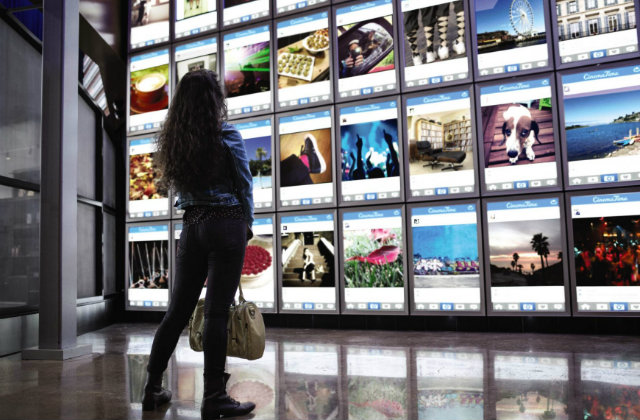
The retail landscape is evolving, whether you like it or not. The disruption of mobile devices acts as the catalyst for a massive change, and there is no sign of slowing down. This is an era of digital transformation (and digital darwinism, to quote Brian Solis).
If you are a retailer, technology is not your enemy. It gives you the invaluable opportunity to deliver powerful and meaningful customer experiences. This is the key to succeed in digital markets, where the quality of your product is not enough. What are the customer experience trends that will shape the future of retail?
You may think that the wave is already gone but what we see now are only the first signs of a revolution that will completely disrupt the retail customer experience. The merging of the physical and digital worlds will accelerate in the next years:
"The retail value chain is unbundling, and even remapping. To compete effectively, traditional retailers should reimagine how they create and capture value, thinking past omnichannel positioning to examine, and find the best uses for, their assets." (Deloitte)
The arise of the smartphone has brought the world to new - and somewhat unexpected - directions. In a business perspective, the main effect of the mobile mind shift is the replacement of traditional consumers with empowered digital customers.
Digital customers show peculiar behaviors and go through a distinctive customer journey, moving back and forth from the online to the offline experience. The ability to reach them in the most critical micro moments of truth is what separate a random brand from a memorable brand.
Mobile commerce is estimated to rise to $62 billion dollars in the next five years, and it is already among the fastest growing segments in retail. Retailers need to adapt their strategies for the new customer, relying on technology as the key to generate engagement and loyalty.
As stated by Google's recent changes to the search engine algorithm, clients have a better opinion of companies that offer a great experience on all channels, mobile-first. At the same time, they are ready to turn to a competitor when they don’t get what they want, when they want it, their own way.
Retailers warned: If you think that the retail customer experience is limited to the physical layer of the store, then you are destined to lack behind. At the same time, Amazon's recent opening proves that the physical store is all but doomed. It just needs to be reinvented to appeal digital customers.
In a recent article on Harvard Business Review, Werner Reinartz, Professor of Marketing at the University of Cologne, states that in the next future we will never not shopping. A paradigm shift in customer behaviors apparent in three ways:
Instant Purchasing - Customers want to fulfill their needs and desires right when they appear. They do not want to wait; they do not need to, because the answer is in their hands, one tap away. Amazon Prime Now, targeted actionable notifications and the buy buttons on social networks are few examples of how brands can react to this change.
Automated Purchasing - Intelligent tools that can take action, even before the customers becomes aware of the problem, they do not come from the pages of a sci-fi novel but from the labs of innovative companies. One example, the fridge that can auto-refill, ordering products based on previous purchasing patterns. This will affect online and retail sales.
Subscription Purchasing - Subscription based services are also undermining the role of brick-and-mortars. We usually connect this type of relationship to entertainments-focused services like Netflix, Spotify, but the idea of membership is spreading across all kind of businesses. Even traditional retail must face it, as we will see in a moment.

The assumption is that people expect retailers to deliver an amazing customer experience - compelling yet easy - across all stages of the customer journey. The path to the future of retail starts with the need to reinvent the identity of the store.
SEAMLESS RETAIL EXPERIENCE
In a mobile ecosystem, the presence of multiple touchpoints mean that retail brands already extend way beyond the concrete walls of the store. If the digital customer journey has been completely reinvented by the smartphone, retailers need to connect with customers across different channels simultaneously and seamlessly.
For example, everyone should be able to browse products in-store, check the features online, purchase the product on the e-commerce and finally pick it up at the shop, receiving post-purchase services via Facebook Messenger (maybe by a chatbot).
DIGITAL STORE EXPERIENCE
The path is evident: the only way for retailers to keep customers in their stores is to revolutionize the concept of physical location, digitalizing the real world and taking advantage of disruptive technologies to adapt their identity (i.e. digital signage).
The interaction - virtual and physical - between the customer and the product is essential to create an immersive and personalized in-store experience. The Internet of Things, digital screens, beacons and other tools offer new opportunities to build customer engagement and say goodbye to the old store layout.
RELATIONSHIPS COMMERCE:
In the digital era, retailers may never beat the e-commerce giants on the ground of price and instant availability, but they can rely on one critical element to differentiate themselves: the experience. They should step from selling products to selling experience.
The focus here is on the creation of long-lasting relationships, built across all steps of the product discovery and purchasing. The membership economy is changing the logic of customer engagement, and loyalty is not a matter of cards anymore. Part of the answer lies in personalized and contextual contents, game mechanics and social connections.
MOBILE & SOCIAL SHOPPING
Though we will not put cash and traditional credit cards away any time soon, mobile payments are already changing the way we make purchases. The industry has gone beyond mobile wallets to implement new technologies like NFC, fingerprint recognition and wearables.
"Kill the checkout", this is the imperative. A seamless one-touch payment is on the horizon, thanks to the wearables revolution and the upgrading of mobile devices. According to Forrester Research, mobile payments will amount to $90 billion in the coming years, and retailers must be ready for this huge shift.
MACHINE LEARNING & SMART DATA
How can you understand how customers' tastes and needs evolve? How can you use this knowledge to take better decisions? Amazon is the clear demonstration of the power of machine learning and smart data. Know what your customer wants before he knows.
As retailers become able to track how users interact with the product, the website, the app and the store, new powerful metrics emerge to help them improve efficiency. Smart Data is an opportunity but also a threat: balancing data and privacy concerns will be vital because the future of retail lies in the hands of customers.
If you want more insights on this topic, take a look at The Future of Retail 2016 - How To Reinvent The Customer Experience.
Editor's Note: This post was originally published in November 2014 and has been completely revamped and updated for accuracy with the latest trends and advancements of mobile technology and retail customer experience.
To help you provide a strategic advantage to your organization, Neosperience has crafted the first DCX 7-Steps Checklist, with requirements and insights for a successful digital transformation. Download the free guide here:



 Your magnifing glass to deeply understand your users and increase the value of each relatonship.
Your magnifing glass to deeply understand your users and increase the value of each relatonship. Listen to the voice of your customers deeply to understand what they truly want.
Listen to the voice of your customers deeply to understand what they truly want. The Lead Generation Platform to get leads from anonymous traffic on your website.
The Lead Generation Platform to get leads from anonymous traffic on your website.  Understand the behavior of people in physical spaces and monitor safety requirements.
Understand the behavior of people in physical spaces and monitor safety requirements. The Digital Commerce Platform designed to follow the most modern technological standards..
The Digital Commerce Platform designed to follow the most modern technological standards.. The XReality platform to tell brand and product stories by connecting physical and digital worlds.
The XReality platform to tell brand and product stories by connecting physical and digital worlds. Points, rewards, levels, badges, missions: a world of nudges to nurture your customer community.
Points, rewards, levels, badges, missions: a world of nudges to nurture your customer community. Discover all the other solutions!
Discover all the other solutions!









